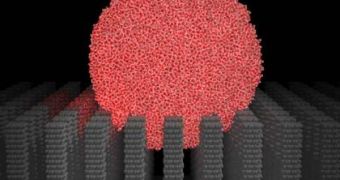Over the next few years, researchers at the University of Nebraska-Lincoln and at Japan's RIKEN Institute believe that the world could witness the rise of self-cleaning walls, fabrics, counter tops, and maybe even the emergence of small water-walking robots. In nature, the latter phenomenon already exists, in a class of insects known as water striders, which effortlessly walk on the liquid. They employ a physical property known as super hydrophobia, which basically means that they strongly repel water.
Physicists have been studying this property for at least 75 years, but they have thus far made only little progress in their investigations. “A lot of people study this and engineers especially like the water strider because it can walk on water. Their legs are super hydrophobic and each leg can hold about 15 times their weight. 'Hydrophobic' means water really doesn't like their legs and that's what keeps them on top. A lot of scientists and engineers want to develop surfaces that mimic this from nature,” the UNL Ameritas University Professor of Chemistry Xiao Cheng Zeng explains.
A collaborative effort, undertaken together with colleagues Takahiro Koishi, from the University of Fukui and the RIKEN Institute, Kenji Yasuoka, from the Keio University, as well as Shigenori Fujikawa and Toshikazu Ebisuzaki, also from the RIKEN Institute, allowed Zeng to publish a new study about super-hydrophobic materials. The paper, which appears in the May 4-8 online issue of the journal Proceedings of the National Academy of Sciences, gives engineers and research teams around the world a new insight into how to construct this amazing class of materials.
In 2005, when the investigation started, RIKEN's supercomputer was the fastest in the world. The team has made good use of it ever since, creating simulations in which they literally “rained down” virtual water molecules on virtual pillars, made up to simulate various lengths and widths. The distance between the pillars themselves was also simulated in abundance, as thousands of such processes were logged into the supercomputer.
“This kind of simulation – we call it 'computer-aided surface design' – can really help engineers in designing a better nanostructured surface. In the Cassie state, the water droplet stays on top and it can carry dirt away. In the Wenzel state, it's sort of stuck on the surface and lacks self-cleaning functionality. When you build a nanomachine – a nanorobot – in the future, you will want to build it so it can self-clean,” Zeng adds.
“We wanted to design a grand-challenge project so we could take advantage of the RIKEN super computer. We thought this was an interesting project and we need a very, very fast computer to deal with it. I also have to acknowledge the Nebraska Research Initiative, the Department of Energy and the National Science Foundation. The NRI is great because it allows me to do highly risky research, to develop this kind of challenging project,” he concludes.

 14 DAY TRIAL //
14 DAY TRIAL //